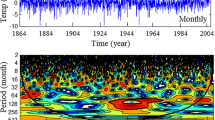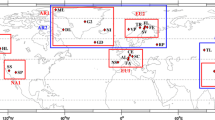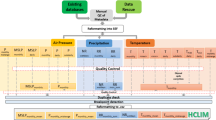Abstract
This paper presents an attempt to summarize various sparse proxy series into continuous and exhaustive climatic data. Freeze-up and break-up dates, early meteorological records and tree-ring data have been combined for the Hudson Bay region and 22 continuous proxy series extending from 1700 to 1979 have been deduced. These new series in term provided the basis for a regressive reconstruction of six seasonal temperature series. Verification tests are successful mainly for the high frequencies components. The low frequencies variability is better estimated by a best analogues method. Both kinds of reconstructions have been combined to improve the results. The main characteristic of the reconstructions is a warming trend beginning at the end of the 19th century. Evidence for a beat wave resulting from 22-year solar and 18.6-year lunar nodal tidal cycles is presented. A phase analysis showed results consistent with other studies of summer temperature variability: temperature maxima correspond to sunspot minima ending an even cycle and are emphasized by the lunar maxima. Different phenomena are pointed out for autumn and winter temperatures: their maxima coincide to sunspot even maxima amplified by lunar minima. In spring, the transition season, these signals are not apparent.
Similar content being viewed by others
References
Allen, W. T. R.: 1977, ‘Freeze-up, Break-up and Ice Thickness in Canada’, Fisheries and Environment Canada, AES, CLI-1-77, p. 185.
Ball, T. F. and Kingsley, R. A.: 1984, ‘Instrumental Temperature Records at Two Sites in Central Canada: 1768 to 1910’, Climatic Change 6, 39–56.
Bell, E. P.: 1983a, ‘The Combined Solar and Tidal Influence on Climate’, Variations of the Solar Constant, NASA Conf. Publ. CP-2191, S. S. Sofia (ed.), Washington.
Berger, A., Goossens, C., and Pestiaux, P.: 1984, ‘Predictability of the Wolf Sunspot Numbers’, Solar Terrestrial Predictors Workshop, Meudon, 18–22 June 1984.
Catchpole, A. J. W.: 1980, ‘Historical Evidence of Climatic Change in Western and Northern Canada’, in Harington (ed.), Syllogeus, 26, Nat. Museum of Nat. Sci., Ottawa, pp. 17–60.
Cropper, J. P. and Fritts, H. C.: 1981, ‘Tree-ring with the Chronologies from the North America Arctic’, Arctic and Alpine Research 13, 245–260.
Currie, R. G.: 1981, ‘Evidence for 18.6 yr M n Signal in Temperature and Drought Conditions in North America since AD 1800’, Journal of Geophysical Research 86, 11055–11064.
Currie, R. G.: 1984, ‘Evidence for 18.6-year Lunar Nodal Drought in Western North America During the Past Millennium’, Journal of Geophysical Research 89, 1295–1308.
Eddy, J. A.: 1977, ‘Climate and the Changing Sun’, Climatic Change 1, 173–190.
Fairbridge, R. W.: 1984, ‘Planetary Periodicities and Terrestrial Climate Stress’, in N. A. Morner and W. Karlen (eds.), Climatic Changes on a Yearly to Millenial Basis, D. Reidel Publ, Co., Dordrecht, Holland, pp. 509–520.
Fritts, H. C., Blasing, T. J., Haydn, B. P., and Kutzbach, J. E.: 1971, ‘Multivariate Techniques for Specifying Tree-growth and Climate Relationships and for Reconstructing Anomalies in Paleoclimate’, Journal of Applied Meteorology 10, 845–864.
Guiot, J.: 1985a, ‘Reconstruction of Seasonal Temperatures and Sea-level Pressures in the Hudson Bay Area Back to 1700’, Climatological Bulletin 19, 11–59.
Guiot, J.: 1985b, ‘Climate of the Hudson Bay Region and Effects of Solar Activity, Volcanic Dust, and Lunar Nodal Tidal Signal’, Solar-terrestrial relationships and the environment in the last millennia, International School of Physics E. Fermi, Varenna, Italy, 20 June–5 July 1985 (in press).
Hansell, R. (ed.): 1984, ‘Study on Temporal Development of Subarctic Ecosystems - Determination of the Relationship Between Tree-ring Increments and Climate’, Report to Department of Supply and Services, contract OSU84-00041, p. 200.
Imbrie, J. and Kipp, N. G.: 1971, ‘A New Micropaleontological Method for Quantitative Palaeo-Climatology, Application to a Late Pleistocene Carribean Core’, in K. Turekian (ed.), The Late Cenozic Glacial Ages, Yale University Press, pp. 71–181.
Kelly, P. M., Jones, P. D., Sear, C. B., Cherry, B. S. G., and Tavakol, R. K.: 1982, ‘Variations in Surface Air Temperatures: Part 2, Arctic Regions, 1881–1980’, Monthly Weather Review 110, 71–83.
Manley, G.: 1974, ‘Central England Temperatures: Monthly Means 1659 to 1973’, Quarterly Journal of the Royal Meteorological Society 100, 389–405.
Mitchell, J. M., Jr., Stockton, C. W., and Meko, D. M.: 1979, ‘Evidence of a 22-year Rhythm of Drought in the Western United States Related to the Hale Solar Cycle since the 17th Century’, in B. M. McCormac and T. A. Seliga (eds.), Solar-Terrestrial Influences on Weather and Climate, D. Reidel Publ. Co., Dordrecht, Holland, pp. 125–135.
Moodie, D. W. and Catchpole, A. J. W.: 1975, ‘Environmental Data from Historical Documents by Content Analysis: Freeze-up and Break-up of Estuaries on Hudson Bay, 1714–1871’, Manitoba Geographical Studies, Univ. Manitoba, Geogr. Dept., Winnipeg, 5, p. 119.
Namias, J.: 1978, ‘Multiple Causes of the North American Abnormal Winter 1976–1977’, Monthly Weather Review 106, 279–295.
Parker, M. C., Jozsa, L. A., Johnson, S. S., and Bramhall, P. A.: 1981, ‘Part II: White Spruce Annual Ring Width and Density Chronologies from near Great Whale River (Cri Lake) Quebec’, in Harington, C. R. (ed.), Syllogeus, Nat. Museum of Nat. Sci., Ottawa, 33, 154–188.
Pittock, A. B.: 1979, ‘Solar Cycles and the Weather: Successful Experiments in Autosuggestion?’, in B. M. McCormac and T. A. Seliga (eds.), Solar-Terrestrial Influences on Weather and Climate, D. Reidel Publ. Co., Dordrecht, Holland, pp. 181–191.
Pittock, A. B.: 1983, ‘Solar Variability, Weather and Climate: An Update’, Quaterly Journal of the Royal Meteorological Society 109, 23–55.
Rannie, W. F.: 1983, ‘Break-up and Freeze-up of the Red River at Winnipeg, Manitoba, Canada in the 19th Century and Some Climatic Implications’, Climatic Change 5, 283–296.
Schuurmans, C. J. E.: 1983, ‘Differences in Tropospheric Thermal Behaviour Between Alternate Solar Cycles’, in B. M. McCormac, (ed.), Weather and Climate Responses to Solar Variations, D. Reidel Publ. Co., Dordrecht, Holland, pp. 559–568.
Stockton, C. W., Mitchell, J. M., Jr, and Meko, D. O.: 1983, ‘A Reappraisal of the 22-yr Drought Cycle’, in B. M. McCormac (ed.), Weather and Climate Responses to Solar Variations, D. Reidel Publ. Co., Dordrecht, Holland, pp. 507–515.
Author information
Authors and Affiliations
Rights and permissions
About this article
Cite this article
Guiot, J. Reconstruction of seasonal temperatures in Central Canada since A.D. 1700 and detection of the 18.6- and 22-year signals. Climatic Change 10, 249–268 (1987). https://doi.org/10.1007/BF00143905
Received:
Revised:
Issue Date:
DOI: https://doi.org/10.1007/BF00143905




